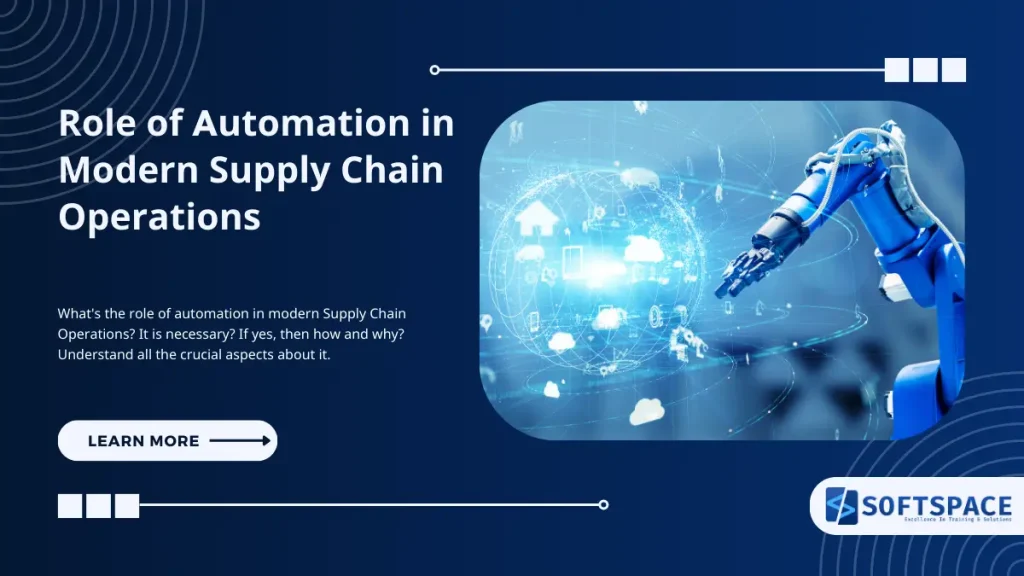The supply chain’s a beast—a sprawling web of moving parts that can make or break a business. From raw materials to finished goods landing in a customer’s hands, it’s a mix of timing, precision, and grit. But today’s world doesn’t mess around—customers want their stuff fast, cheap, and flawless, while companies scramble to keep costs in check and shelves stocked.
So, what’s the role of automation in modern Supply Chain Operations? Let’s understand. It is the quiet powerhouse reshaping how this all works. It’s not about robots stealing jobs or flashy sci-fi gimmicks; it’s about streamlining workflows, boosting speed, and keeping everything running smoothly. In a game where every second counts, automation is rewriting the rules of the modern supply chain.

Role of automation in modern supply chain operations
| Area of Supply Chain | Role of Automation | Impact/Benefits (with Data/Studies) |
|---|---|---|
| Warehousing | Use of Automated Guided Vehicles (AGVs), robots, and warehouse management systems (WMS) | Increases warehouse productivity by 25–35% and reduces order processing time by up to 50% (McKinsey, 2022) |
| Inventory Management | Automated inventory tracking using RFID, IoT, and AI | Reduces inventory holding costs by 10–30% and improves accuracy to 98%+ (Deloitte, 2023) |
| Order Fulfilment | Robotics and AI-driven picking & packing systems | Enhances fulfilment speed by 2–3x and reduces human error by up to 70% (LogisticsIQ, 2023) |
| Transportation & Logistics | Route optimisation via AI, autonomous delivery vehicles, drone delivery | Reduces transportation costs by up to 15% and delivery time by 20–25% (Gartner, 2023) |
| Procurement | E-procurement platforms using AI for vendor selection and price prediction | Cuts procurement processing time by up to 40% and increases supplier compliance (Capgemini, 2022) |
| Demand Forecasting | Predictive analytics and machine learning models | Improves forecast accuracy by up to 85–95% (PwC, 2023) |
| Customer Service | Chatbots and automated email responders | Reduces response time by up to 60% and increases customer satisfaction scores (Forrester, 2023) |
| Returns Management | Automation in reverse logistics and return label generation | Shortens return processing time by up to 40% and reduces cost per return (Accenture, 2022) |
| Compliance & Documentation | Automated compliance checks and digital paperwork | Reduces compliance risks and saves up to 30% in documentation processing time (World Bank Logistics Report, 2023) |
| End-to-End Visibility | Use of integrated platforms for real-time tracking | Increases transparency and reduces supply chain disruptions by up to 50% (IBM, 2023) |
Streamlining with Smart Tools
Take an apparel warehouse buzzing with orders—boxes flying, pickers weaving, and deadlines looming. That’s where tools like order fulfillment software come in, flipping chaos into clockwork. Picture it: a customer clicks “buy,” and the software kicks in—checking stock, plotting the fastest pick path, and spitting out a shipping label before the coffee’s cold.
It’s not just about speed; it’s about nailing every step without a hiccup. For businesses, that means fewer fumbles—less “where’s my package?” grief—and happier buyers. It’s a taste of how automation slots into the supply chain, turning a grind into a glide.
Streamlining Logistics Operations
Shipping’s a beast of its own—trucks, planes, and boats crisscrossing the globe, all while fuel costs bite and delays lurk. Automation is like a sharp knife here, trimming the waste. Think route-planning systems that dodge traffic snarls or load-balancing tools that pack trucks to the brim without guesswork. It’s not about replacing drivers; it’s about giving them a map that works.
Pair that with real-time tracking—letting you ping a pallet’s location from factory to front door—and you’ve got a leaner, meaner flow. The payoff? Lower costs, tighter timelines, and a supply chain that doesn’t sweat the small stuff.
Keeping Stock in Check
Inventory’s a tightrope—too much, and you’re drowning in dust; too little, and you’re turning folks away. Here, automation steps in like a hawk-eyed stock clerk. Smart systems can watch sales patterns, ping suppliers for refills, and shuffle goods between warehouses before anyone notices a gap.
It’s not about gut calls; it’s about knowing what’s needed, when, and where. If a hot item’s flying off shelves, the tech flags it early, keeping the pipeline primed. That kind of foresight keeps cash flowing and customers coming back; no crystal ball is required.
Smoothing the Human Hustle
Let’s be real—people are the backbone of any supply chain, from forklift jockeys to desk jockeys crunching orders. Automation doesn’t boot them out; it hands them better tools.
Picture a picker with a headset that barks the next grab or a manager with a dashboard showing every cog in the wheel. It’s not about working harder; it’s about working sharper—cutting the busywork so folks can focus on what machines can’t touch, like troubleshooting a snag or charming a supplier. The vibe shifts from frazzled to focused, and that’s gold when you’re scaling up.
Dodging the Curveballs
Supply chains love a good plot twist—strikes, storms, or a random part shortage can derail the best plans. Automation is your buffer here. Think predictive tech that sniffs out trouble, like a port clogging up, and reroutes shipments before the panic hits.
Or systems that juggle priorities when a big order crashes in, keeping the small fries happy too. It’s not foolproof, but it’s a shield, soaking up shocks that’d otherwise send you scrambling. That resilience lets you roll with the punches, not just duck them.
Talking Across the Chain
A supply chain’s only as strong as its weakest link, and misfires between players—suppliers, makers, shippers—can gum up the works. Automation is the glue here, syncing everyone up.
Shared platforms let a factory ping a supplier for parts the second stock dips or a retailer nudge a carrier when a rush order’s ready. It’s not just chatter; it’s a live feed keeping the whole crew in lockstep. No more phone tag or crossed wires—just a clean, clear line from start to finish. That harmony’s clutch when you’re juggling a dozen partners across the map.
Scaling Without Stumbling
Growth’s the dream, but it’s a beast to wrangle—more orders, more stops, more everything. Automation’s built to stretch. Start small—maybe a picking bot in one warehouse—then roll it out as you add hubs or crank up the volume.
The tech scales with you, tweaking itself to match the load without a full teardown. It’s not about betting the farm on day one; it’s about planting seeds that grow as you do. That flexibility keeps your supply chain tight, whether you’re a local business or chasing global turf.
The Long Haul
Automation is not a shiny toy—it’s a shift in how supply chains breathe. It’s about squeezing every drop of juice from the system, from warehouse floors to delivery vans, without breaking the bank or the team.
It’s the edge that turns a scrappy operation into a slick one, ready for whatever the market throws next. With tools like order fulfillment software leading the charge, modern supply chains aren’t just surviving—they’re thriving, one smart move at a time.

13+ Yrs Experienced Career Counsellor & Skill Development Trainer | Educator | Digital & Content Strategist. Helping freshers and graduates make sound career choices through practical consultation. Guest faculty and Digital Marketing trainer working on building a skill development brand in Softspace Solutions. A passionate writer in core technical topics related to career growth.




